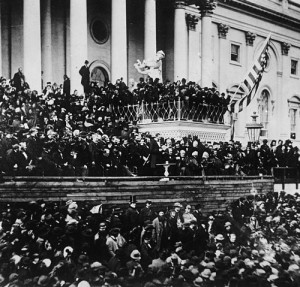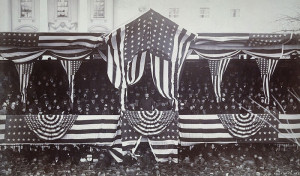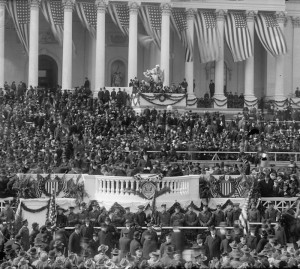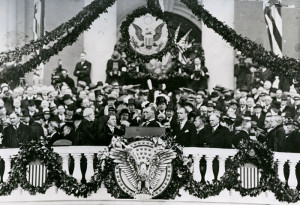Inaugurations require flags

The inauguration of President Donald J. Trump calls to mind many flag-bedecked ceremonies of the past. Here’s a sampling:
1865
Abraham Lincoln’s second inauguration brought out flags, partly to salute him and partly to celebrate the upcoming end of the Civil War. A Washington newspaper reported that “the national flag in some shape, mammoth or miniature, was to be seen at every available point along [Pennsylvania] avenue, and upon various carriages, cars, harness or horses,…giving an exceedingly lively appearance to the scene.”
As Lincoln delivered his second inaugural address, a large American flag flew at his left. In the crowd beneath that banner lurked John Wilkes Booth, who would soon murder the Great Emancipator.
1885

Preparations for the inauguration of President Grover Cleveland kept D.C. workers on their toes, reported The Daily Critic in Washington, D.C. “The busiest workmen in the city today are the decorators,” an article noted. “The houses along Pennsylvania avenue…are receiving their coating of flags, bunting, shields and decorating paraphernalia in general.”
1917

“Inaugural to be a Patriotic Display” read a headline in The Evening Star of Washington on the day President Woodrow Wilson began his second term.
The committee in charge of the events invited citizens’ organizations to “decorate their homes with the United States flags during the inaugural period.” The flags, the committee suggested, “should be flung to the breeze on a pole.”
1941

When Franklin D. Roosevelt started his unprecedented third term, “the program concluded with the most impressive presentation of ‘The Star-Spangled Banner,’” said The Evening Star.
On hand for the occasion were actors Douglas Fairbanks, Mickey Rooney, Ethel Barrymore and Charlie Chaplin, who watched as “from the ceiling of the hall was released a large American flag which hung over the heads of all those honoring the inauguration of the president.”
As impressive as all those national inaugurations were, a state event rivaled them. When Theodore Bilbo was sworn in as governor of Mississippi in 1916, he stood before a 300-pound version of Old Glory that was generously loaned for the occasion by Ohio businessmen “as an expression of its appreciation of the return of that era of good feeling between the citizens of the North and South.”
